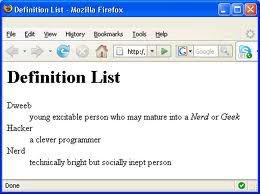Listed below are the most common attributes you can use for the definition list element:
- class - provides the class or classes of the heading. This attribute is used to identify the name of the style class or classes to be used for rendering.
- id - provides a unique name for the heading.
- lang - provides the language in which the enclosed content is coded.
- style - provides a cascading style sheet (CSS) properties to the heading.
- title - privides a text title for the heading. Most web browser displays the value of the title as "tooltip".
Here's an example on how to use the definition list <dl> element:
<!DOCTYPE html PUBLIC "-//W3C//DTD XHTML 1.0 Transitional//EN"
"http://www.w3.org/TR/xhtml1/DTD/xhtml1-transitional.dtd">
<html xmlns="http://www.w3.org/1999/xhtml">
<head>
<meta http-equiv="Content-Type" content="text/html;
charset=utf-8" />
<mate name="keywords" content="blog, web development" />
<title>the DEFINITION LIST element</title>
</head>
<body>
<h1>
the DEFINITION LIST element
</h1>
<dl>
<dt>Data Encryption Algorithm (DEA)</dt>
<dd>
<p>
Symmetric block cipher, defined as part of the U.S. government's Data Encryption Standard.Generally speaking, in U.S. government systems, there will be an algorithm, which is the mathematical engine, and a standard, which is the fully working implementation.
</p>
</dd>
<dt>packet filter</dt>
<dd>
<p>
One of the simplest and earliest forms of a firewall, a packet filter accepts or rejects traffic based on source and destination address, and possibly the type of traffic.
</p>
</dd>
</dl>
</body></html>







0 comments:
Post a Comment